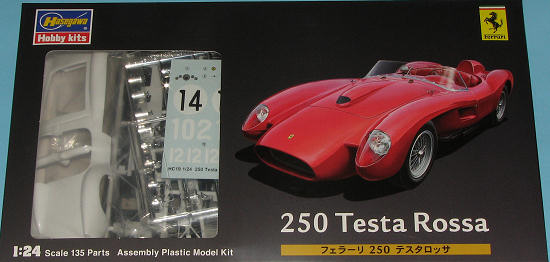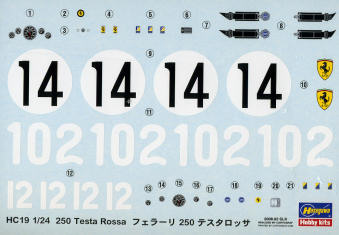
| KIT: | Hasegawa 1/24 Ferrari 250 Testa Rossa |
| KIT #: | 21219 ( HC-19) |
| PRICE: | $ |
| DECALS: | Four options |
| REVIEWER: | Scott Van Aken |
| NOTES: | New mold kit |

| HISTORY |
The Ferrari TR, or 250 Testa Rossa, is a race car model built by Ferrari in the 1950's and 1960's. These cars dominated their arenas, with variations winning the 24 Hours of Le Mans in 1958, 1960, and 1961. They were closely related to the rest of the Ferrari 250 line, especially the legendary 250 GTO.
In all, 34 250 Testa Rossas were built, from 1956 through 1961. The phrase "Testa Rossa" means "redhead." The most well known, the 250TR, was produced from 1957 to 1958; only 2 factory cars and 19 customer cars were built. After the 250 GTO, the 250 Testa Rossa is the second most valuable Ferrari model, often valued at more than US$8,000,000.
Named for the red valve covers, the original 250 TR had unorthodox bodywork by Scaglietti. The front fenders are visually separated from the central "nacelle" body, a design inspired Formula One racers, with air ducting across the front brakes and out through the open area behind the wheels, this model is often called the "Pontoon" TR. Olivier Gendebien and Phil Hill won the 24 Hours of Le Mans with this car in 1958.
Ferrari used to provide a number designation for all its cars based on the capacity of a single piston. So the 250 Testa Rossa was 250 cc times 12 cylinders for a displacement of 3 liters. Often the only way to distinguish between different cars using the same engine was by the letters or name following the numerical designation.
| THE KIT |
 Hasegawa
is not one of a names most car builders dredge up when considering kits.
However, Hasegawa has produced a number of very nice kits (and a few that
are best forgotten) over the years. Their newer items are as nice as
anything made by the others in the field and better than most.
Hasegawa
is not one of a names most car builders dredge up when considering kits.
However, Hasegawa has produced a number of very nice kits (and a few that
are best forgotten) over the years. Their newer items are as nice as
anything made by the others in the field and better than most.
This particular kit consists of 135 parts molded on sprues of black, white and clear plastic. One sprue is chrome plated, though modelers wishing to remove the molding seams on some parts will need to repaint them. Alclad II Chrome is an excellent choice in this regard as it not only has great shine, but is also not so brilliant as to appear toy-like. The wire wheel representations are especially noteworthy in how well they are molded. The kit also includes four very nicely molded rubber tires. The body parts are all molded in white to assist as a background for the Ferrari Red paint.
The kit is not a curbside and comes with a complete engine, transmission and drive line. The molding on the parts is superb. Hasegawa seems to have gone to lengths to keep those pesky ejector pin marks from being a problem. From what I can see, any that are extant will be covered by other parts or invisible after construction. The kit also provides the ability to display the hood open and has steerable front wheels.
These cars were generally of a tube
frame construction. Hasegawa has duplicated that framework in the engine and
passenger compartment. There are not many options, but some are available.
That includes exterior door hinges, a right side air scoop and a tonneau
cover for the passenger compartment (which the instructions call 'passenger
seat food').
Instructions are well done, as we have come to expect from Hasegawa. They are mostly in Japanese with some English explanations scattered about. Gunze paints are provided for reference, but should not be a hindrance for those who cannot find them. There is a rather large decal sheet that provides markings for a stock Ferrari and three racing cars. These decals are provided for the instruments and for the seat belts as well. No reference is provided for the three number sets given, but one is for the 1958 Le Mans winning car (#14) as driven by Phil Hill. Unfortunately, that car had a different front end from what is provided in the kit, but the thought is appreciated. The three number set (102) is probably for the Mille Miglia as cars participating in that event usually had three numbers. The final set is for an unknown car, but it is nice to have the option. Decals are the new type from Hasegawa so should work just fine with standard setting solutions.
| CONCLUSIONS |
This is really an exceptional kit of a very famous 1950s Ferrari. I'm particularly pleased to see it released and I'm sure others will be as well. It is a kit that does not look too complex, yet has all the detail one could want.
| REFERENCES |
http://en.wikipedia.org
April 2008
My thanks to
www.dragonmodelsusa.com for the
review kit. Get yours today at your local shop or have them order one for you. If you would like your product reviewed fairly and quickly, please
contact
me or see other details in the
Note to
Contributors.